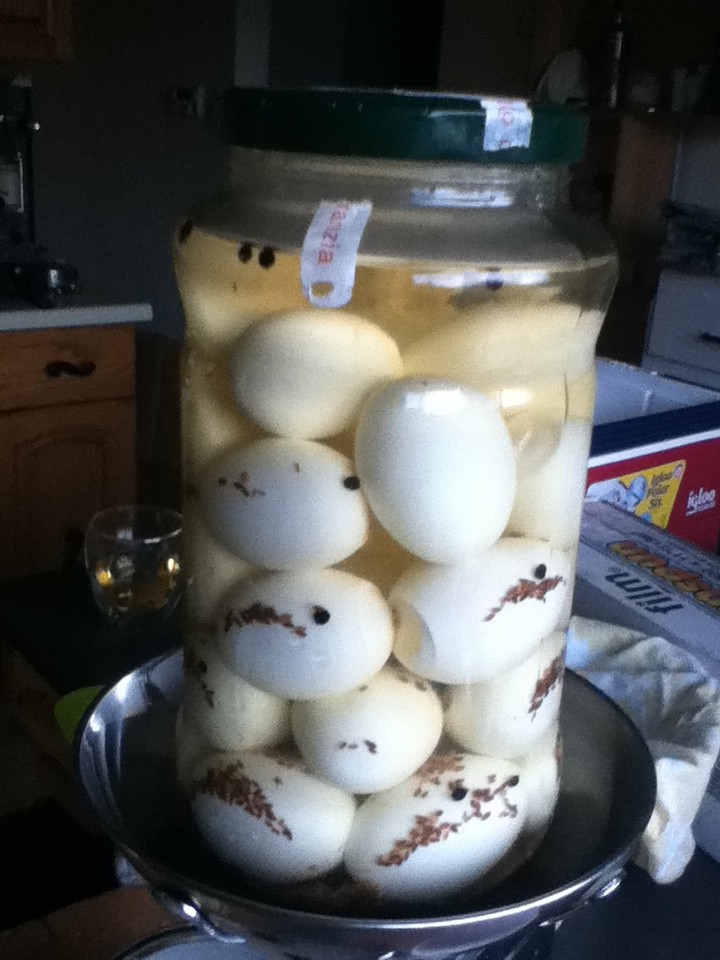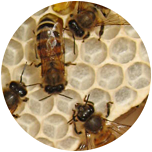 Well over a decade ago, I owned a restaurant, and in the restaurant I sold pickled eggs. I also had a fully waxed handlebar moustache—so there are at least two reasons why I find hipsters to be Johnny-come-lately poseurs.
Well over a decade ago, I owned a restaurant, and in the restaurant I sold pickled eggs. I also had a fully waxed handlebar moustache—so there are at least two reasons why I find hipsters to be Johnny-come-lately poseurs.
Anyhow, I sold pickled eggs but I never ate one—they seemed disgusting to me.I have a thing about food textures, which is why I hate zucchini and eggplant, and have an uneasy relationship with mushrooms. Pickled eggs are in no way texturally challenging. I am a giant fan of dill pickles, to the extent of getting a jar of Polskie Ogorki in the toe of my Christmas stocking every year,And getting quite shirty with girlfriends who neglected that particular holiday tradition. but I didn’t like the idea of pickled eggs. But a couple of years ago, on a road-trip deli break, I cautiously nibbled a pickled egg and found they are in fact a perfect marriage of hard-boiled convenience and dill pickle. Add to this chicken’s winter moult that slows egg production and it seemed pickling would be a good way to extend egg season.Yes, I have watched Doomsday Preppers and seen the eggs stored in mineral oil. Please enjoy this 1977 article from Mother Earth News on How to store fresh eggs.
So last year I busted out the National Centre for Home Food Preservation’s recipe for pickled eggs and made cidered eggs, dilled eggs and also a recipe for Amish Beet Eggs. All were enjoyable; the cidered eggs were earthy and spicy, the beet eggs a lovely pink colour, but I preferred the simple dilled eggs.I do add a few juniper berries, because I love Gin.
Now pickling eggs by following the NCHFP recipe is not exactly innovative, but stay with me.
Rather than boiling the eggs, I steam them. Not only does this save energy because you are heating a smaller amount of water and you can cook a whole steamer pot full, steaming seems to make the eggs peel more easily. Last year I steamed 36 eggs at once, and found they were slightly underdone, so this year I did a dozen at a time, steamed for fifteen minutes. You could do larger batches, but you will need to test the cooking time. As a starting point, I would add a couple of minutes steaming time for each dozen eggs I added to the basket, so 36 eggs should steam for around 20 minutes.
When the eggs are done, pull the steamer pot off, and, as you walk them to your bowl of cool or ice water, give the steamer a good shake.Please do not shake as hard as in this method of peeling a head of garlic. This cracks the shells and lets the cold water in through the cracks. This year my eggs almost peeled themselves, despite being farm-fresh.
Place your peeled eggs in a jar, giving a quart of space per dozen eggs, and add a peeled garlic clove per dozen eggs.This is a perfect use for the cloves that were too small for planting. Pour boiling brine over the eggs as per your selected NCHFP recipe, let the jar cool slightly and refrigerate. Let the eggs pickle for at least two weeks, but a month is better. And then enjoy.

[…] on deck this week; Being a treatise on Significant Innovations in Egg Pickling, in which I drop two major bombs on the debate about how to hard-boil eggs. Answer: […]